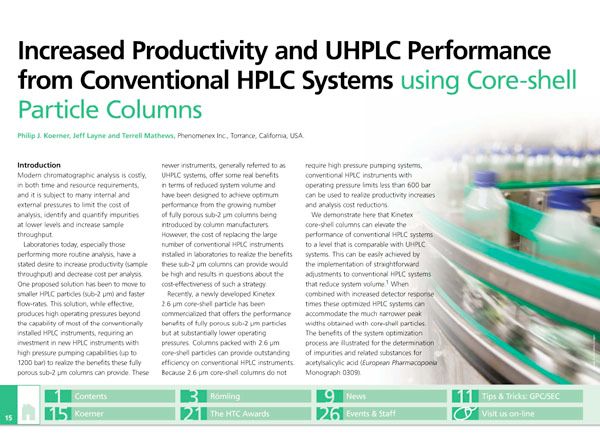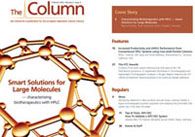Increased Productivity and UHPLC Performance from Conventional HPLC Systems using Core-shell Particle Columns
Demonstrating core-shell columns that can elevate the performance of conventional HPLC systems to a level that is comparable with UHPLC systems.
Modern chromatographic analysis is costly, in both time and resource requirements, and it is subject to many internal and external pressures to limit the cost of analysis, identify and quantify impurities at lower levels and increase sample throughput.
Laboratories today, especially those performing more routine analysis, have a stated desire to increase productivity (sample throughput) and decrease cost per analysis. One proposed solution has been to move to smaller HPLC particles (sub-2 µm) and faster flow-rates. This solution, while effective, produces high operating pressures beyond the capability of most of the conventionally installed HPLC instruments, requiring an investment in new HPLC instruments with high pressure pumping capabilities (up to 1200 bar) to realize the benefits these fully porous sub-2 µm columns can provide. These newer instruments, generally referred to as UHPLC systems, offer some real benefits in terms of reduced system volume and have been designed to achieve optimum performance from the growing number of fully porous sub-2 µm columns being introduced by column manufacturers. However, the cost of replacing the large number of conventional HPLC instruments installed in laboratories to realize the benefits these sub-2 µm columns can provide would be high and results in questions about the cost-effectiveness of such a strategy.
Recently, a newly developed Kinetex 2.6 μm core-shell particle has been commercialized that offers the performance benefits of fully porous sub-2 μm particles but at substantially lower operating pressures. Columns packed with 2.6 μm core-shell particles can provide outstanding efficiency on conventional HPLC instruments. Because 2.6 μm core-shell columns do not require high pressure pumping systems, conventional HPLC instruments with operating pressure limits less than 600 bar can be used to realize productivity increases and analysis cost reductions.
We demonstrate here that Kinetex core-shell columns can elevate the performance of conventional HPLC systems to a level that is comparable with UHPLC systems. This can be easily achieved by the implementation of straightforward adjustments to conventional HPLC systems that reduce system volume.1 When combined with increased detector response times these optimized HPLC systems can accommodate the much narrower peak widths obtained with core-shell particles. The benefits of the system optimization process are illustrated for the determination of impurities and related substances for acetylsalicylic acid (European Pharmacopoeia Monograph 0309).
New Study Reviews Chromatography Methods for Flavonoid Analysis
April 21st 2025Flavonoids are widely used metabolites that carry out various functions in different industries, such as food and cosmetics. Detecting, separating, and quantifying them in fruit species can be a complicated process.
Extracting Estrogenic Hormones Using Rotating Disk and Modified Clays
April 14th 2025University of Caldas and University of Chile researchers extracted estrogenic hormones from wastewater samples using rotating disk sorption extraction. After extraction, the concentrated analytes were measured using liquid chromatography coupled with photodiode array detection (HPLC-PDA).

.png&w=3840&q=75)

.png&w=3840&q=75)



.png&w=3840&q=75)



.png&w=3840&q=75)







